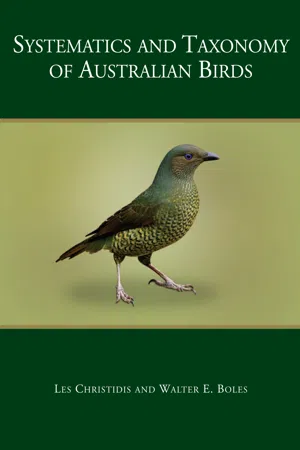![]()
Systematics and taxonomy
of Australian birds
PALAEOGNATHAE
ORDER STRUTHIONIFORMES
Family Struthionidae
The introduced Struthio camelus (Ostrich) occurs, or has occurred, in Australia. This was regarded as being represented by subspecies australis Gurney, 1868 from southern Africa (Condon 1975). Sequences of the mitochondrial control region indicate that this form is closest to the eastern African population massaicus Neumann, 1898 (Robinson and Matthee 1999). It is possible that Australian birds are now extinct as a wild population and thus the species should be transferred to the supplementary list.
No changes have been made from Christidis and Boles (1994).
Struthio camelus | OstrichI/E? |
ORDER CASUARIIFORMES
Family Casuariidae
Christidis and Boles (1994) treated the Dromaiidae and Casuariidae as subfamilies within a single family, following the osteo-logical studies by Patterson and Rich (1987). Livezey and Zusi (2007) retained these as separate families. One family is recognised here, with Casuariidae Kaup, 1847, having priority over Dromaiidae Huxley, 1868. This action is supported by DNA–DNA hybridisation (Sibley and Ahlquist 1981) and 12S RNA sequence (Cooper et al. 1992). The latter study showed that the divergence between the two is no greater than that between the species of kiwi Apteryx. Lee et al. (1997) and Cracraft et al. (2004) used the family name Dromiceidae [sic] for the emus. Dromaiidae Huxley, 1868, has priority over Dromiceiidae Richmond, 1908 (Bock 1994) – note the correct formation of the latter. Dromiceius and Dromaius appeared in the same publication by Vieillot (1816); the former name has page priority (p. 54 versus p. 70), but was regarded by Serventy et al. (1965) to be a misprint and that it should be rejected as an incorrect original spelling.
Parker (1984) demonstrated that the dwarf emus of Kangaroo Island and King Island were morphologically distinct and should be regarded as separate species, taking the names Dromaius baudinianus S.A. Parker, 1984, and D. ater Vieillot, 1817, respectively. The taxonomic level at which the now extinct Tasmanian population (diemenensis) should be recognised has yet to be resolved (see Patterson and Rich 1987); until the question is investigated further, this form has been retained in D. novaehollandiae (Emu)
Casuarius casuarius | Southern Cassowary |
Dromaius novaehollandiae | Emu |
Dromaius ater | King Island EmuE |
Dromaius baudinianus | Kangaroo Island EmuE |
NEOGNATHAE
Galloanseres
ORDER GALLIFORMES
Australia has three native species each of megapodes and quail, but there are a number of other galliform species kept either in a domestic state or in aviaries that have become established in a feral state, or have the potential to do so.
Sibley et al. (1988), Sibley and Ahlquist (1990) and Sibley and Monroe (1990; see errata in Sibley and Monroe 1993) placed the megapodes (Megapodiidae) and the Neotropical currasows, guans and chachalacas (Cracidae) together in the order Craciformes as the sister clade to the remaining taxa (sometimes collectively called the typical galliforms or phasianoids). Subsequent authors have not adopted this division. The distinctiveness of the megapodes and cracids is evident, but subsequent authors, using morphological and molecular techniques, have found that these do not form a clade separate from the phasianoids. Instead, the Megapodiidae and Cracidae are successive sister groups to the phasianoids – an arrangement that has gained consensus among most workers (e.g. Cracraft 1973, 1981; Johnsgard 1986; Brom and Dekker 1992; Harshman 1994; del Hoyo 1994; Livezey and Zusi 2001; Mayr 2000; Dimcheff et al. 2000, 2002; Madge and McGowan 2002; Dyke and Gulas 2002; Dyke 2003; Dyke et al. 2003; Dickinson 2003; Cracraft et al. 2004; Pereira and Baker 2006; Crowe et al. 2006).
Within the phasianoids, there are several major divisions: guineafowl, New World quail, Old World quail, turkeys, grouse, francolins, spurfowl, peafowl and several groups of partridges and pheasants. While these have been identified in most broad studies, there is less concordance about their inter-relationships and taxonomic rankings, with groups being variously treated as families, subfamilies or tribes. For example, Johnsgard (1986, 1988), del Hoyo et al. (1994) and Madge and McGowan (2002) accepted five families and Dickinson (2003) accepted three.
Sibley et al. (1988) identified three major lineages in the typical Galliformes: Numididae (guineafowls), Odontophoridae (New World quails) and Phasianidae (grouse, pheasants, partridges, turkeys, Old World quails). Helm-Bychowski and Wilson (1986) analysed 161 restriction sites in the nuclear DNA of Gallus, Alectoris, Meleagris, Phasianus, Pavo and Numida and concluded that of these genera, Numida was the most divergent lineage and most appropriately placed in its own family. Turbott (1990) and AOU (1998), however, retained the guineafowl as a subfamily in the Phasianidae. Recognition of the Odontophoridae at family level is well supported by osteology (Holman 1964; Mourer-Chaviré 1992), biochemistry (Gutierréz et al. 1983), mitochondrial and nuclear DNA (e.g. Kornegay et al. 1993; Kimball et al. 1999; Cracraft et al. 2004; Pereira and Baker 2006; Crowe et al. 2006), and has been generally accepted in recent publications (e.g. del Hoyo 1994; AOU 1998; Madge and McGowan 2002; Dickinson 2003). Armstrong et al. (2001), employing the mitochondrial cytochrome-b gene, found the Numididae in a more derived position than the Odontophoridae, whereas the nuclear marker avian ovomucoid intron G...






